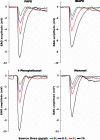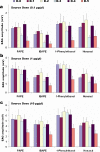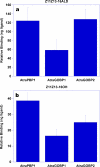Pheromone binding to general odorant-binding proteins from the navel orangeworm
- PMID: 20535533
- PMCID: PMC2895864
- DOI: 10.1007/s10886-010-9811-5
Pheromone binding to general odorant-binding proteins from the navel orangeworm
Abstract
General odorant-binding proteins (GOBPs) of moths are postulated to be involved in the reception of semiochemicals other than sex pheromones, the so-called "general odorants." We have expressed two GOBPs, AtraGOBP1 and AtraGOBP2, which were previously isolated from the antennae of the navel orangeworm, Amyelois transitella. Surprisingly, these two proteins did not bind compounds that are known to attract adult moths, particularly females. The proper folding and functionality of the recombinant proteins was inferred from circular dichroism analysis and demonstration that both GOBPs bound nonanal in a pH-dependent manner. EAG experiments demonstrated that female attractants (1-phenylethanol, propionic acid phenyl ester, and isobutyric acid phenyl ester) are detected with high sensitivity by the antennae of day-0 to day-4 adult females, with response declining in older moths. The same age-dependence was shown for male antennae responding to constituents of the sex pheromone. Interestingly, AtraGOBP2 bound the major constituent of the sex pheromone, Z11Z13-16Ald, with affinity comparable to that shown by a pheromone-binding protein, AtraPBP1. The related alcohol bound to AtraPBP1 with higher affinity than to AtraGOBP2. AtraGOBP1 bound both ligands with low but nearly the same affinity.
Figures






Similar articles
-
Olfactory proteins mediating chemical communication in the navel orangeworm moth, Amyelois transitella.PLoS One. 2009 Sep 30;4(9):e7235. doi: 10.1371/journal.pone.0007235. PLoS One. 2009. PMID: 19789654 Free PMC article.
-
Moth sex pheromone receptors and deceitful parapheromones.PLoS One. 2012;7(7):e41653. doi: 10.1371/journal.pone.0041653. Epub 2012 Jul 20. PLoS One. 2012. PMID: 22911835 Free PMC article.
-
Two subclasses of odorant-binding proteins in Spodoptera exigua display structural conservation and functional divergence.Insect Mol Biol. 2015 Apr;24(2):167-82. doi: 10.1111/imb.12143. Epub 2014 Oct 24. Insect Mol Biol. 2015. PMID: 25345813
-
Pheromone reception in moths: from molecules to behaviors.Prog Mol Biol Transl Sci. 2015;130:109-28. doi: 10.1016/bs.pmbts.2014.11.005. Epub 2014 Dec 16. Prog Mol Biol Transl Sci. 2015. PMID: 25623339 Review.
-
Molecular mechanisms underlying sex pheromone production in moths.Biosci Biotechnol Biochem. 2010;74(2):223-31. doi: 10.1271/bbb.90756. Epub 2010 Feb 7. Biosci Biotechnol Biochem. 2010. PMID: 20139627 Review.
Cited by
-
Molecular characterization, expression pattern, and ligand-binding property of three odorant binding protein genes from Dendrolimus tabulaeformis.J Chem Ecol. 2014 Apr;40(4):396-406. doi: 10.1007/s10886-014-0412-6. Epub 2014 Apr 12. J Chem Ecol. 2014. PMID: 24728949 Free PMC article.
-
Identification and characterization of two general odorant binding protein genes from the oriental fruit moth, Grapholita molesta (busck).J Chem Ecol. 2012 Apr;38(4):427-36. doi: 10.1007/s10886-012-0102-1. Epub 2012 Mar 28. J Chem Ecol. 2012. PMID: 22454283
-
Quasi-double-blind screening of semiochemicals for reducing navel orangeworm oviposition on almonds.PLoS One. 2013 Nov 14;8(11):e80182. doi: 10.1371/journal.pone.0080182. eCollection 2013. PLoS One. 2013. PMID: 24244643 Free PMC article.
-
Binding Properties of General Odorant Binding Proteins from the Oriental Fruit Moth, Grapholita molesta (Busck) (Lepidoptera: Tortricidae).PLoS One. 2016 May 6;11(5):e0155096. doi: 10.1371/journal.pone.0155096. eCollection 2016. PLoS One. 2016. PMID: 27152703 Free PMC article.
-
Identification of Chemosensory Genes, Including Candidate Pheromone Receptors, in Phauda flammans (Walker) (Lepidoptera: Phaudidae) Through Transcriptomic Analyses.Front Physiol. 2022 Jul 1;13:907694. doi: 10.3389/fphys.2022.907694. eCollection 2022. Front Physiol. 2022. PMID: 35846004 Free PMC article.
References
-
- Biessmann H, Andronopoulou E, Biessmann MR, Douris V, Dimitratos SD, Eliopoulos E, Guerin PM, Iatrou K, Justice RW, Krober T, et al. The Anopheles gambiae odorant binding protein 1 (AgamOBP1) mediates indole recognition in the antennae of female mosquitoes. PLoS ONE. 2010;5:e9471. doi: 10.1371/journal.pone.0009471. - DOI - PMC - PubMed
-
- Gong ZJ, Zhou WW, Yu HZ, Mao CG, Zhang CX, Cheng JA, Zhu ZR. Cloning, expression and functional analysis of a general odorant-binding protein 2 gene of the rice striped stem borer, Chilo suppressalis (Walker) (Lepidoptera: Pyralidae) Insect Mol. Biol. 2009;18:405–417. doi: 10.1111/j.1365-2583.2009.00886.x. - DOI - PubMed

